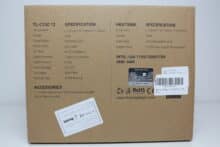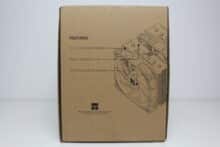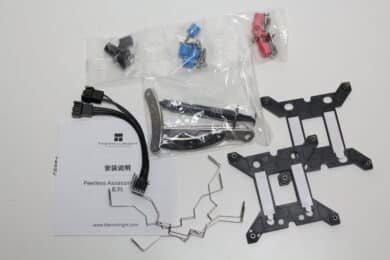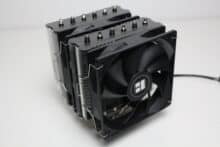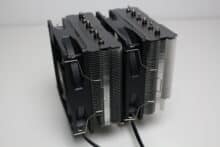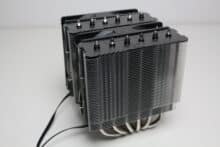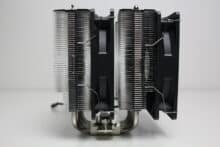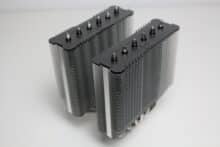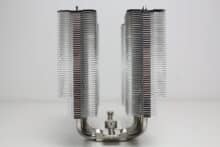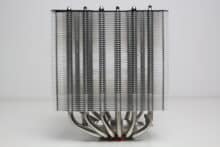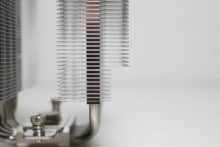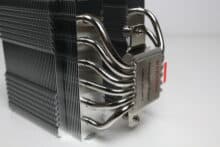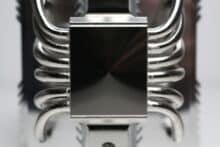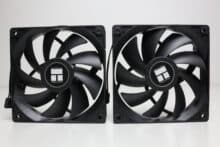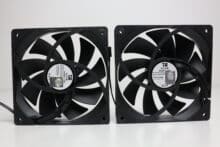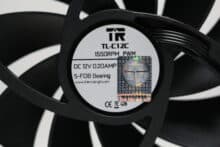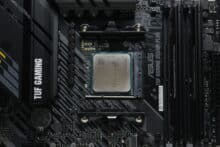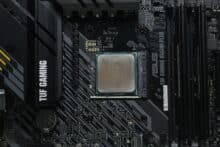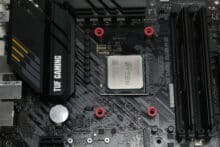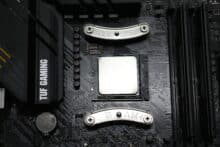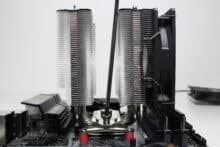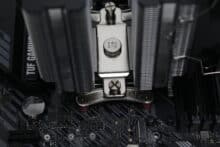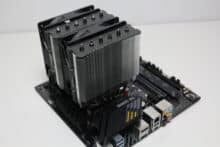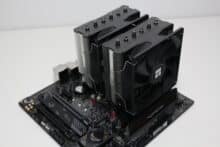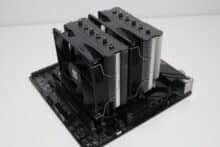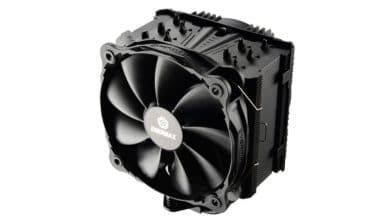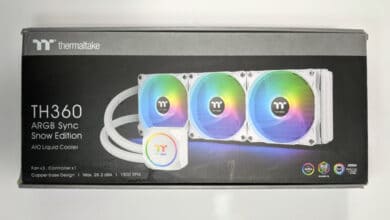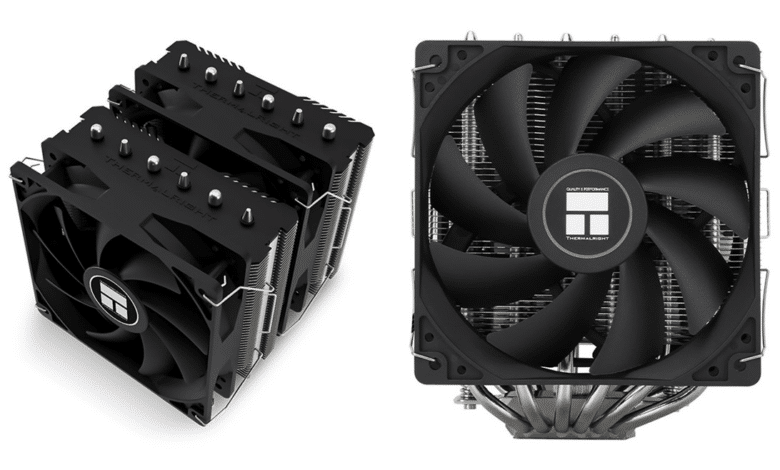
The manufacturer Thermalright was founded in Taipei (Taiwan) in 2001 and has been developing air and water coolers as well as other cooling components for PC systems ever since. The Macho CPU cooler caused the first real stir in the summer of 2012, presenting very good cooling performance, not only due to its massive dimensions, and was therefore further developed in two further revisions. A little later, Thermalright even included a special screwdriver with the Macho, as it was almost impossible to install with conventional screwdrivers.
However, after the distributor PC-Cooling discontinued the operation and sale of Thermalright products at the beginning of 2020, it initially became very quiet around the manufacturer in Germany. About 18 months ago, however, the manufacturer returned with a new CPU cooler, which has been extremely popular ever since. Even though we are a little late, we didn’t want to miss the opportunity to put the Thermalright Peerless Assassin 120 SE to the test. The standard version of the Peerless Assassin 120 SE costs just Price: € 35.59 *. The RGB or white version costs only marginally more.
Thermalright Peerless Assassin 120 SE review: Technical details
General specifications
| Dimensions (with fan): | 125 x 155 x 135 mm (W x H x D) |
| Weight (with fan): | 970 g |
| Material: | Copper (heatpipes and base plate, nickel-plated), aluminum (cooling fins) |
| Heatpipes: | 6 x Ø 6 mm |
| Cooling capacity: | N/A |
| Compatibility AMD: | AM5, AM4 |
| Intel compatibility: | LGA,1700, LGA1200, LGA115x |
| Price: | Price: € 35.59 * |
Fan specifications
| Fan designation: | Thermalright TL-C12C |
| Bearing type: | Fluid Dynamic Bearing (FDB) |
| Dimensions: | 120 x 120 x 25 mm |
| Number of fans: | 2 |
| Fan speed: | max. 1550 rpm |
| Noise level: | 25.6 db(A) – N/A |
| Delivery volume: | max. 112.4 m³/h |
| static pressure: | 1.53 mmH2O |
| Operating voltage: | 12 V |
| Voltage range: | 0,2 A |
| Power consumption: | 2,4 W |
| Connection: | 4-pin PWM |

Packaging & scope of delivery
Thermalright packs the Peerless Assassin 120 SE in a plain brown cardboard box. On the outside, we find the product name as well as some schematic illustrations of the CPU cooler, a list of the most important features and a table with all the technical data. Inside the box, Thermalright wraps the heat sink and the two fans in plastic film and places the box with the mounting accessories between the two cooling towers.
The scope of delivery includes the heat sink, two 120 mm fans and the mounting accessories. These are divided into spacers, mounting brackets, backplates and screws, all of which are required to mount the Peerless Assassin 120 SE on all current mainstream sockets. There is also a tube of thermal paste, mounting instructions, four fan clips and a Y-splitter cable for connecting the fans.
Design & workmanship
The Thermalright Peerless Assassin 120 SE is a classic CPU cooler with a twin-tower design and two fans. With a weight of 970 grams and dimensions of 125 x 155 x 135 mm (W x H x D), it is also one of the heavier and bulkier CPU coolers. In terms of design, Thermalright has kept the look simple with silver and black elements.
Both cooling towers have 50 aluminum fins each, but only the top one is painted black and bears the manufacturer’s logo. All other fins remain shiny silver. A total of six heat pipes, each with a diameter of six millimeters, are responsible for transferring the heat from the CPU to the aluminium fins. If you also look at the heat sink from the front, you will notice that it has an asymmetrical design. This is to ensure that there are no compatibility problems with the PCIe slots on the mainboard.
The two TL-C12C fans supplied are based on the 120 mm format and are completely black. They are each connected via a 4-pin PWM connector, but can be connected to a motherboard header using the supplied adapter cable. The manufacturer specifies 1550 revolutions per minute as the maximum speed of the 9-bladed rotor. Small rubber buffers for decoupling can also be seen at the corners.
The build quality of the Thermalright Peerless Assassin 120 SE is okay and corresponds to the targeted price range. There are no sharp edges on the heat sink and the paint finish on the upper fins is good. There are some minor visual blemishes on the cooler base and the aluminum fins, which are not noticeable when installed and should have no technical impact on the cooling performance, but should be mentioned nonetheless. In terms of its appearance, the Thermalright Peerless Assassin 120 SE is simple, but cannot compete with fully nickel-plated or anodized CPU coolers.
Thermalright Peerless Assassin 120 SE review: Assembly
A test system is used for the review, which is mounted on a benchtable. This allows us to rule out factors such as heat build-up in the case. The test system consists of the following components.
- AMD Ryzen 5 1400 @ 3.8 GHz at 1.175V*
- ASUS TUF Gaming B550M-Plus*
- Crucial Ballistix Sport LT gray 32 GB DDR4-3000*
- Corsair Force Series MP510 960GB Nvme*
- Gigabyte AORUS GTX 1060 6G*
- LC-Power LC550 V2.31 Platinum Series 550W*
When mounting the Peerless Assassin 120 SE, Thermalright relies on a plastic backplate for Intel sockets or on the pre-installed retention module for AMD sockets, which is screwed to the front with a bracket construction and to which the heat sink can then be attached. No special tools are required for installation.
For our AM4 system, the front plastic brackets of the AMD retention module had to be removed first. The four red plastic sleeves were then slipped onto the protruding lugs of the backplate. The silver metal mounting brackets were then placed on top and screwed in place with four screws.
We then applied the thermal paste to the CPU and removed the protective film from the base of the heat sink. In our review, as always, we use Arctic MX-4 and spread it evenly over the heatspreader of the CPU. Next, the heat sink is placed on the CPU and screwed evenly on both sides. In the final step, the fans were then attached to the cooler using the wire brackets.
Mounting the Thermalright Peerless Assassin 120 SE is extremely easy thanks to the bracket design and the freely accessible mounting frame on the heat sink. All the necessary elements are clearly labeled and some are even color-coded. What’s more, no special tools are required for installation and all current Intel and AMD mainstream sockets are supported. If you have any questions, a look at the assembly instructions should provide clarity. Although the instructions are quite compact, the drawings are sufficiently large and clear.
In terms of compatibility, there are no problems with the PCIe slots from our point of view. This could be mainly due to the offset orientation above the socket. However, its great depth could cause problems with higher RAM modules, as the fan is located directly above the RAM slots. In this case, the front fan must be moved further up on the heat sink or attached to the rear. The former is of course always a little unsightly from an optical point of view, but it is possible.
Cooling performance and volume
As already shown in the previous chapter, we use an AM4 system based on the Ryzen 5 1400 and the ASUS TUF Gaming B550M-Plus as test hardware. The Ryzen runs at 3.8 GHz at 1.175 V. To heat up the processor, it was loaded with Prime95 for 30 minutes. The temperature of the CPU was then read out with the CPUID hardware monitor. The room temperature was always around 20 °C during the measurements.
| wdt_ID | CPU-Kühler | Temperatur 50% PWM (in °C) | Temperatur 100% PWM (in °C) | Minimale Lüftergeschwindigkeit (in U/min) | Lüftergeschwindigkeit bei 50% PWM (in U/min) | Lüftergeschwindigkeit bei 100% PWM (in U/min) | Minimale Pumpengeschwindigkeit (in U/min) | Pumpengeschwindigkeit bei 50% PWM (in U/min) | Pumpengeschwindigkeit bei 100% PWM (in U/min) |
|---|---|---|---|---|---|---|---|---|---|
| 123 | Thermaltake TH280 V2 ARGB | 46,60 | 45,90 | 550 | 1.200 | 1.800 | 680 | 2.100 | 3.200 |
| 124 | Cooler Master MasterLiquid 240 Atmos ARGB | 50,40 | 46,50 | 560 | 1.340 | 2.270 | 1.965 | 6.620 | 10.230 |
| 125 | be quiet! Pure Loop 2 240mm | 50,70 | 46,70 | 800 | 1.070 | 2.080 | 4.150 | 4.700 | 5.530 |
| 126 | Alpenföhn Panorama 2 | 76,00 | 66,80 | 450 | 1.450 | 2.720 | |||
| 127 | Alpenföhn Brocken 4 | 53,60 | 49,60 | 410 | 870 | 1.610 | |||
| 128 | AMD Wraith Stealth | 95,00 | 76,00 | 800 | 1.430 | 2.630 | |||
| 129 | Corsair A115 | 49,40 | 46,90 | 190 | 920 | 1.560 | |||
| 130 | Thermalright Peerless Assassin 120 SE | 49,50 | 47,50 | 350 | 1.050 | 1.680 | |||
| 131 | Thermalright Assassin X 120 SE | 53,60 | 50,60 | 340 | 1.070 | 1.690 | |||
| 132 | DeepCool Assassin IV (Silent) | 51,40 | 48,70 | 500 | 860 | 1.330 | |||
| CPU-Kühler | Temperatur 50% PWM (in °C) | Temperatur 100% PWM (in °C) | Minimale Lüftergeschwindigkeit (in U/min) | Lüftergeschwindigkeit bei 50% PWM (in U/min) | Lüftergeschwindigkeit bei 100% PWM (in U/min) | Minimale Pumpengeschwindigkeit (in U/min) | Pumpengeschwindigkeit bei 50% PWM (in U/min) | Pumpengeschwindigkeit bei 100% PWM (in U/min) |
As can be seen from the table and the diagram, the CPU of our test system reaches a maximum of 49.5 °C (at 50% PWM fan speed) or 47.5 °C (at 100% PWM fan speed) under full load. If you compare this with previously tested CPU coolers, you can quickly see that the Thermalright Peerless Assassin 120 SE can easily keep up with more expensive high-end coolers, at least in terms of performance. Even the Corsair A115, which we recently tested and which costs around three times as much, is within striking distance.
As always, the maximum noise level of the Peerless Assassin 120 SE depends on the selected fan speed. Below 900 to 1000 revolutions per minute (approx. 40-50% PWM), the fans are very restrained and can hardly or not at all be heard from the system. The minimum speed of 350 revolutions per minute is also a very good value and allows the fan speed to be greatly reduced at idle. At 100% PWM or maximum speed, both fans are clearly audible at approx. 1700 revolutions per minute and are no longer suitable for silent operation.
Conclusion of the Thermalright Peerless Assassin 120 SE test
With the Peerless Assassin 120 SE, Thermalright continues to offer a good overall package for a small budget. Despite its size, the CPU cooler can be mounted easily and securely on many different sockets and has a discreet black and silver look. The Peerless Assassin 120 SE is also available in white or with RGB fans, and at a price that is barely higher. However, we were particularly impressed by the cooling performance of the Peerless Assassin 120 SE. Despite its relatively low price, it can easily keep up with significantly more expensive CPU coolers and should even be able to keep more powerful CPUs sufficiently cool.
It should be clear that there are not only positive aspects to a relatively inexpensive CPU cooler. We initially found the overall workmanship to be somewhat negative. Although this is generally not bad, small flaws and blemishes can be seen in one place or another. When installed, however, these were not visible and had no influence on the performance shown. Furthermore, the overall appearance is not as elegant and simple as that of other CPU coolers. Finally, it should be mentioned that the fans are clearly audible, especially at higher speeds, and a certain amount of vibration was perceptible.
Considering the overall package on offer and the purchase price of just Price: € 35.59 *, the Thermalright Peerless Assassin 120 SE is and remains an absolute price/performance tip that can easily compete with more powerful CPUs, significantly more expensive high-end air coolers and smaller AiO water cooling systems. However, if you want to getthe last bit of performance out of it, you will have to live with a slightly higher noise level.
Thermalright Peerless Assassin 120 SE
Design
Workmanship
Mounting
Performance
Value for money
91/100
The Thermalright Peerless Assassin 120 SE is a very high-performance and visually discreet CPU cooler that is easy to install and offers an excellent price-performance ratio. However, you have to do without a particularly high-quality finish or appearance.




